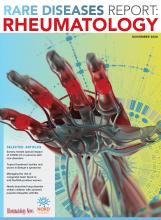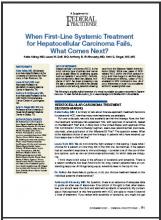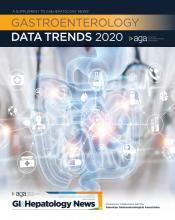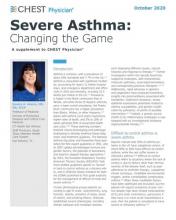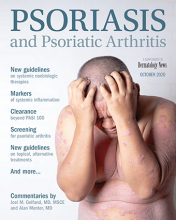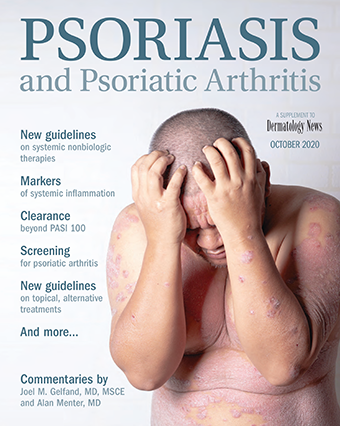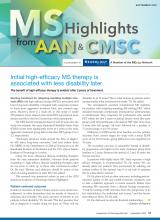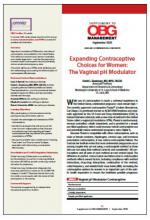User login
RARE DISEASES REPORT: RHEUMATOLOGY
- Survey reveals special impact of COVID-19 on persons with rare disorders
- Topical treatment tackles oral ulcers in Behçet’s syndrome
- Managing the risk of congenital heart block in anti-Ro/SSA-positive women
- Newly described lung disorder strikes children with systemic juvenile idiopathic arthritis
- Survey reveals special impact of COVID-19 on persons with rare disorders
- Topical treatment tackles oral ulcers in Behçet’s syndrome
- Managing the risk of congenital heart block in anti-Ro/SSA-positive women
- Newly described lung disorder strikes children with systemic juvenile idiopathic arthritis
- Survey reveals special impact of COVID-19 on persons with rare disorders
- Topical treatment tackles oral ulcers in Behçet’s syndrome
- Managing the risk of congenital heart block in anti-Ro/SSA-positive women
- Newly described lung disorder strikes children with systemic juvenile idiopathic arthritis
When First-Line Systemic Treatment for Hepatocellular Carcinoma Fails, What Comes Next?
The following is a lightly edited transcript of a virtual roundtable discussion recorded in September 2020. To view the full discussion, go to www.mdedge.com/FedPrac/HCC-Roundtable.
The following is a lightly edited transcript of a virtual roundtable discussion recorded in September 2020. To view the full discussion, go to www.mdedge.com/FedPrac/HCC-Roundtable.
The following is a lightly edited transcript of a virtual roundtable discussion recorded in September 2020. To view the full discussion, go to www.mdedge.com/FedPrac/HCC-Roundtable.
Gastroenterology Data Trends 2020
Topics include:
Long-Term Impact of COVID-19 on the Practice of Gastroenterology and Endoscopy
John I. Allen, MD, MBA, AGAF
Consolidation Trends in Gastroenterology
Michael Weinstein, MD, AGAF
IBD Management Amid COVID-19
Kim L. Isaacs, MD, AGAF
Racial and Social Disparities in Gastroenterology
Sandra M. Quezada, MD, MS
Impending Physician Shortages in Gastroenterology
Michael Weinstein, MD, AGAF
Recommendations for Colonoscopy and the Management of Large Polyps
Aasma Shaukat, MD, MPH, AGAF
Nonalcoholic Steatohepatitis (NASH): Identifying Patients with High-Risk Disease
Brent Tetri, MD, AGAF
Esophageal Adenocarcinoma: Geographical Clustering and Time Trends
Joel Rubenstein, MD, MSc
Topics include:
Long-Term Impact of COVID-19 on the Practice of Gastroenterology and Endoscopy
John I. Allen, MD, MBA, AGAF
Consolidation Trends in Gastroenterology
Michael Weinstein, MD, AGAF
IBD Management Amid COVID-19
Kim L. Isaacs, MD, AGAF
Racial and Social Disparities in Gastroenterology
Sandra M. Quezada, MD, MS
Impending Physician Shortages in Gastroenterology
Michael Weinstein, MD, AGAF
Recommendations for Colonoscopy and the Management of Large Polyps
Aasma Shaukat, MD, MPH, AGAF
Nonalcoholic Steatohepatitis (NASH): Identifying Patients with High-Risk Disease
Brent Tetri, MD, AGAF
Esophageal Adenocarcinoma: Geographical Clustering and Time Trends
Joel Rubenstein, MD, MSc
Topics include:
Long-Term Impact of COVID-19 on the Practice of Gastroenterology and Endoscopy
John I. Allen, MD, MBA, AGAF
Consolidation Trends in Gastroenterology
Michael Weinstein, MD, AGAF
IBD Management Amid COVID-19
Kim L. Isaacs, MD, AGAF
Racial and Social Disparities in Gastroenterology
Sandra M. Quezada, MD, MS
Impending Physician Shortages in Gastroenterology
Michael Weinstein, MD, AGAF
Recommendations for Colonoscopy and the Management of Large Polyps
Aasma Shaukat, MD, MPH, AGAF
Nonalcoholic Steatohepatitis (NASH): Identifying Patients with High-Risk Disease
Brent Tetri, MD, AGAF
Esophageal Adenocarcinoma: Geographical Clustering and Time Trends
Joel Rubenstein, MD, MSc
Severe Asthma: Changing the Game
In this supplement to CHEST Physician, Dr. Sandra Adams investigates the following topics:
- Difficult-to-control vs severe asthma
- T2-high inflammatory endotype
- T2-low endotype
- Biologic therapies in severe asthma
- Treatment follow-up and assessment
Click here to read.
Author
Sandra G. Adams, MD, MS, FCCP
Division of Pulmonary
Diseases and Critical Care Medicine
UT Health San Antonio
Staff Physician,
Care System
San Antonio, TX
In this supplement to CHEST Physician, Dr. Sandra Adams investigates the following topics:
- Difficult-to-control vs severe asthma
- T2-high inflammatory endotype
- T2-low endotype
- Biologic therapies in severe asthma
- Treatment follow-up and assessment
Click here to read.
Author
Sandra G. Adams, MD, MS, FCCP
Division of Pulmonary
Diseases and Critical Care Medicine
UT Health San Antonio
Staff Physician,
Care System
San Antonio, TX
In this supplement to CHEST Physician, Dr. Sandra Adams investigates the following topics:
- Difficult-to-control vs severe asthma
- T2-high inflammatory endotype
- T2-low endotype
- Biologic therapies in severe asthma
- Treatment follow-up and assessment
Click here to read.
Author
Sandra G. Adams, MD, MS, FCCP
Division of Pulmonary
Diseases and Critical Care Medicine
UT Health San Antonio
Staff Physician,
Care System
San Antonio, TX
PEDIATRIC BEHAVIORAL AND MENTAL HEALTH
- Reduce mental illness stigma
- Ready for school? Not many preschoolers with ADHD are
- Suicide screening is key
- Alcohol, opioid misuse tied to risky behaviors
- Identify runaway risk
- Reduce mental illness stigma
- Ready for school? Not many preschoolers with ADHD are
- Suicide screening is key
- Alcohol, opioid misuse tied to risky behaviors
- Identify runaway risk
- Reduce mental illness stigma
- Ready for school? Not many preschoolers with ADHD are
- Suicide screening is key
- Alcohol, opioid misuse tied to risky behaviors
- Identify runaway risk
Psoriasis and Psoriatic Arthritis
Psoriasis and Psoriatic Arthritis is a supplement to Dermatology News with commentary from Joel M. Gelfand, MD, MSCE and Alan Menter, MD.
- Exploring new guidelines and scientific advances
- ‘Loss-framed’ approach makes psoriasis patients more agreeable to treatment
- Topical PDE-4 inhibitor for psoriasis effective in phase 2b trial
- Biologics may delay psoriatic arthritis
- AAD-NPF releases guidelines for systemic nonbiologic treatments of psoriasis
- Specific markers detect psoriatic disease inflammation without elevated CRP
- Beyond PASI 100: Striving for molecular clearance
- Ultrasound improves specificity of psoriatic arthritis referrals
- Registry data reveal temporal relationship between psoriasis symptoms and PsA onset
- New psoriasis guidelines focus on topical and alternative treatments, and severity measures
- Psoriasis topical combination maintenance strategy hits mark at 1 year
Read the supplement.
Psoriasis and Psoriatic Arthritis is a supplement to Dermatology News with commentary from Joel M. Gelfand, MD, MSCE and Alan Menter, MD.
- Exploring new guidelines and scientific advances
- ‘Loss-framed’ approach makes psoriasis patients more agreeable to treatment
- Topical PDE-4 inhibitor for psoriasis effective in phase 2b trial
- Biologics may delay psoriatic arthritis
- AAD-NPF releases guidelines for systemic nonbiologic treatments of psoriasis
- Specific markers detect psoriatic disease inflammation without elevated CRP
- Beyond PASI 100: Striving for molecular clearance
- Ultrasound improves specificity of psoriatic arthritis referrals
- Registry data reveal temporal relationship between psoriasis symptoms and PsA onset
- New psoriasis guidelines focus on topical and alternative treatments, and severity measures
- Psoriasis topical combination maintenance strategy hits mark at 1 year
Read the supplement.
Psoriasis and Psoriatic Arthritis is a supplement to Dermatology News with commentary from Joel M. Gelfand, MD, MSCE and Alan Menter, MD.
- Exploring new guidelines and scientific advances
- ‘Loss-framed’ approach makes psoriasis patients more agreeable to treatment
- Topical PDE-4 inhibitor for psoriasis effective in phase 2b trial
- Biologics may delay psoriatic arthritis
- AAD-NPF releases guidelines for systemic nonbiologic treatments of psoriasis
- Specific markers detect psoriatic disease inflammation without elevated CRP
- Beyond PASI 100: Striving for molecular clearance
- Ultrasound improves specificity of psoriatic arthritis referrals
- Registry data reveal temporal relationship between psoriasis symptoms and PsA onset
- New psoriasis guidelines focus on topical and alternative treatments, and severity measures
- Psoriasis topical combination maintenance strategy hits mark at 1 year
Read the supplement.
MS Highlights from AAN & CMSC
- Initial high-efficacy MS therapy is associated with less disability later
- Serum NfL in early MS can help predict clinical course
- No benefit of three commonly used medications for MS fatigue
- Telerehabilitation may be effective in MS
- CMSC MRI guidelines evolve into international consensus protocol
- Newest oral DMTs haven’t yet made a big impact in the MS world
Read the supplement.
- Initial high-efficacy MS therapy is associated with less disability later
- Serum NfL in early MS can help predict clinical course
- No benefit of three commonly used medications for MS fatigue
- Telerehabilitation may be effective in MS
- CMSC MRI guidelines evolve into international consensus protocol
- Newest oral DMTs haven’t yet made a big impact in the MS world
Read the supplement.
- Initial high-efficacy MS therapy is associated with less disability later
- Serum NfL in early MS can help predict clinical course
- No benefit of three commonly used medications for MS fatigue
- Telerehabilitation may be effective in MS
- CMSC MRI guidelines evolve into international consensus protocol
- Newest oral DMTs haven’t yet made a big impact in the MS world
Read the supplement.
Expanding Contraceptive Choices for Women: The Vaginal pH Modulator
Vaginal pH modulators (VPMs) add a new class of contraception that is now available in the United States. This method is nonhormonal, woman-controlled, and coitally dependent—and has the potential to increase overall contraceptive use and potentially reduce unintended pregnancy rates.
This CME supplement to OBG Management focuses on VPMs, their attributes, and the methodology surrounding the determination of contraceptive effectiveness.
Vaginal pH modulators (VPMs) add a new class of contraception that is now available in the United States. This method is nonhormonal, woman-controlled, and coitally dependent—and has the potential to increase overall contraceptive use and potentially reduce unintended pregnancy rates.
This CME supplement to OBG Management focuses on VPMs, their attributes, and the methodology surrounding the determination of contraceptive effectiveness.
Vaginal pH modulators (VPMs) add a new class of contraception that is now available in the United States. This method is nonhormonal, woman-controlled, and coitally dependent—and has the potential to increase overall contraceptive use and potentially reduce unintended pregnancy rates.
This CME supplement to OBG Management focuses on VPMs, their attributes, and the methodology surrounding the determination of contraceptive effectiveness.
MS Highlights From the AAN & CMSC Annual Meetings
This supplement to Neurology Reviews compiles MS-related news briefs from the 2020 virtual annual meetings of the American Academy of Neurology and the Consortium of Multiple Sclerosis Centers.
Click here to read the supplement
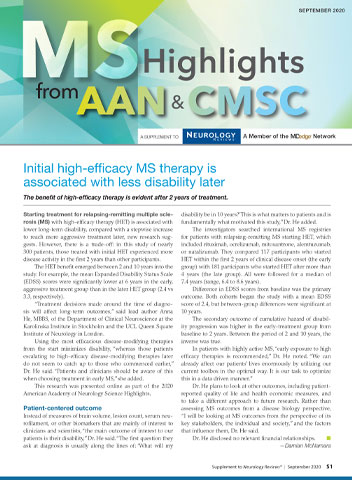
This supplement to Neurology Reviews compiles MS-related news briefs from the 2020 virtual annual meetings of the American Academy of Neurology and the Consortium of Multiple Sclerosis Centers.
Click here to read the supplement

This supplement to Neurology Reviews compiles MS-related news briefs from the 2020 virtual annual meetings of the American Academy of Neurology and the Consortium of Multiple Sclerosis Centers.
Click here to read the supplement

